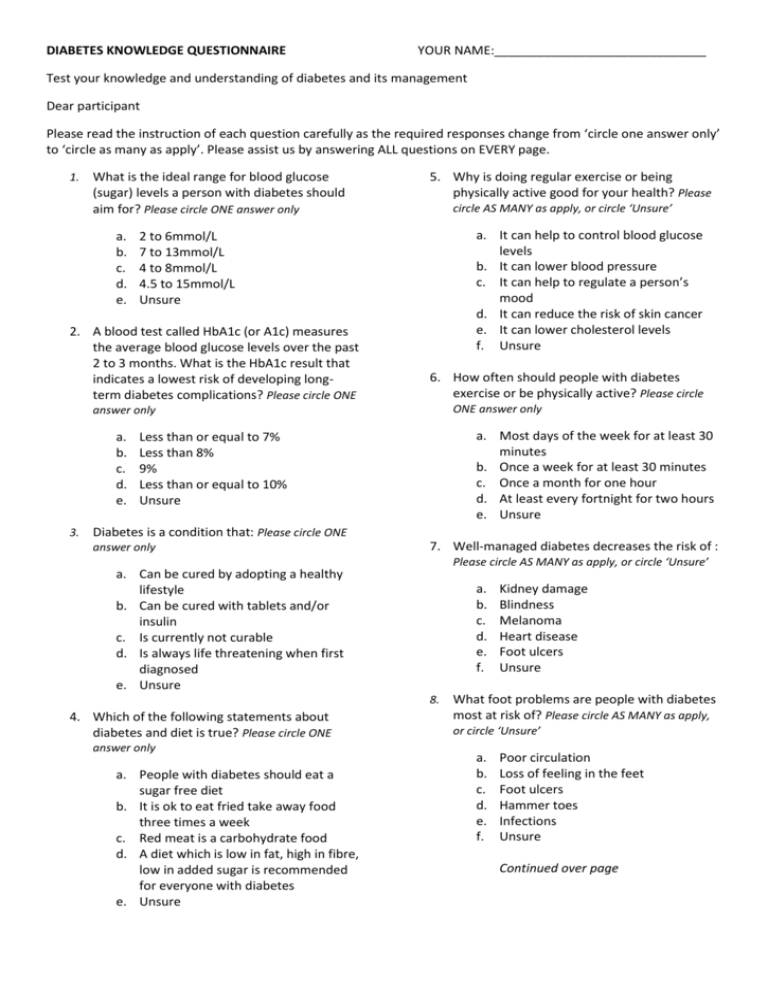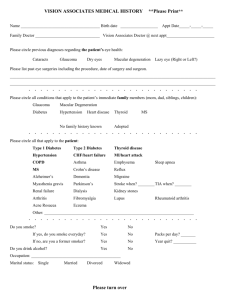Diabetes Knowledge Questionnai
advertisement

DIABETES KNOWLEDGE QUESTIONNAIRE YOUR NAME:______________________________ Test your knowledge and understanding of diabetes and its management Dear participant Please read the instruction of each question carefully as the required responses change from ‘circle one answer only’ to ‘circle as many as apply’. Please assist us by answering ALL questions on EVERY page. 1. What is the ideal range for blood glucose (sugar) levels a person with diabetes should aim for? Please circle ONE answer only a. b. c. d. e. 5. Why is doing regular exercise or being physically active good for your health? Please circle AS MANY as apply, or circle ‘Unsure’ a. It can help to control blood glucose levels b. It can lower blood pressure c. It can help to regulate a person’s mood d. It can reduce the risk of skin cancer e. It can lower cholesterol levels f. Unsure 2 to 6mmol/L 7 to 13mmol/L 4 to 8mmol/L 4.5 to 15mmol/L Unsure 2. A blood test called HbA1c (or A1c) measures the average blood glucose levels over the past 2 to 3 months. What is the HbA1c result that indicates a lowest risk of developing longterm diabetes complications? Please circle ONE 6. How often should people with diabetes exercise or be physically active? Please circle ONE answer only answer only a. b. c. d. e. 3. a. Most days of the week for at least 30 minutes b. Once a week for at least 30 minutes c. Once a month for one hour d. At least every fortnight for two hours e. Unsure Less than or equal to 7% Less than 8% 9% Less than or equal to 10% Unsure Diabetes is a condition that: Please circle ONE answer only 7. Well-managed diabetes decreases the risk of : Please circle AS MANY as apply, or circle ‘Unsure’ a. Can be cured by adopting a healthy lifestyle b. Can be cured with tablets and/or insulin c. Is currently not curable d. Is always life threatening when first diagnosed e. Unsure a. b. c. d. e. f. 8. 4. Which of the following statements about diabetes and diet is true? Please circle ONE answer only a. People with diabetes should eat a sugar free diet b. It is ok to eat fried take away food three times a week c. Red meat is a carbohydrate food d. A diet which is low in fat, high in fibre, low in added sugar is recommended for everyone with diabetes e. Unsure Kidney damage Blindness Melanoma Heart disease Foot ulcers Unsure What foot problems are people with diabetes most at risk of? Please circle AS MANY as apply, or circle ‘Unsure’ a. b. c. d. e. f. Poor circulation Loss of feeling in the feet Foot ulcers Hammer toes Infections Unsure Continued over page 9. Why are people with diabetes advised to test their own blood glucose (BG)? Please circle ONE option only a. To alert them to changes in BG level patterns b. To help make decisions in relation to exercise, treating ‘hypos’ (low BG) or sick day management c. It can make people more confident in looking after their diabetes d. All of the above e. Unsure 10. What should a person with diabetes do if s/he becomes ill (e.g. flu, gastric upset, infection)? Please circle AS MANY as apply, or circle ‘Unsure’ a. Check blood glucose level more frequently (every 2 to 4 hours) b. Stop taking all diabetes tablets and/or insulin c. Drink lots of non-sweet fluid if blood glucose levels are over 15 mmol/L d. Seek medical attention if very unwell and unable to check blood glucose e. Try to do as much exercise as possible to lower blood glucose levels f. Unsure 11. People with diabetes need a medical check-up of their eyes, nerve and kidney function at least: Please circle ONE answer only a. b. c. d. e. Every month Six monthly Once a year Every two to three years Unsure 12. The National Diabetes Services Scheme (NDSS): Please circle AS MANY as apply, or circle ‘Unsure’ a. Allows members to purchase blood glucose testing strips at reduced price b. Offers members free syringes and insulin pen needles c. Is only available to people on low incomes d. Is available to people with all types of diabetes e. Is free to join f. Unsure The following questions (13 and 14) are to be completed by people taking diabetes medication (i.e. blood glucose lowering tablets or insulin) 13. Which of the following statements about diabetes medication is true? Please circle ONE answer only a. If blood glucose levels are normal for two months, diabetes medication can be stopped b. Tablets for diabetes work by increasing blood glucose levels c. Regular medical check-ups are necessary to assess the need for adjustments to diabetes medication d. People taking diabetes medication do not need to worry about healthy eating e. Unsure 14. If a person with diabetes has a hypo (low blood glucose level) reaction, s/he should: Please circle ONE answer only a. Immediately take some insulin or diabetes tablets b. Rest and wait until s/he feels better c. Immediately have some sugary food or drink (e.g. jelly beans, soft drink) d. Drink some diet soft drink e. Unsure 15. A person with type 1 diabetes feeling unwell and unable to eat should: Please circle AS MANY as apply, or circle ‘Unsure’ a. Check blood glucose and ketone levels at least every 2 hours b. Drink carbohydrate containing (sugary) fluids if blood glucose below 15mmol/L c. Go to the hospital if persistent vomiting and/or diarrhoea d. Stop taking all insulin e. Seek medical advice for adjusting insulin doses f. Unsure IF answering this questionnaire electronically i.e. email, please put answers in table below and attach completed document to your return email. Thank you. Question Answer/s Unsure Y / N 8. 1. 9. 2. 10. 3. 11. 4. 12. 5. 13. 6. 14. 7. 15.






